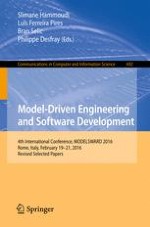2017 | Buch
Model-Driven Engineering and Software Development
4th International Conference, MODELSWARD 2016, Rome, Italy, February 19-21, 2016, Revised Selected Papers
herausgegeben von: Slimane Hammoudi, Dr. Luís Ferreira Pires, Bran Selic, Philippe Desfray
Verlag: Springer International Publishing
Buchreihe : Communications in Computer and Information Science
